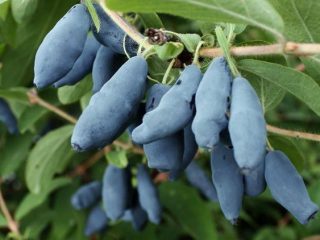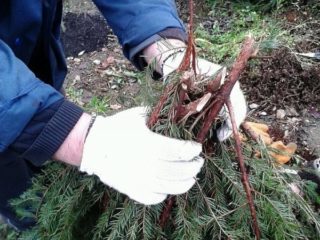Content
Honeysuckle is a relatively unpretentious crop that even an inexperienced novice gardener can maintain in proper condition. Caring for honeysuckle in the spring should include various activities covering the entire range of agrotechnical methods that are used when growing this crop. Typically, the spring work schedule is the busiest, since many important issues must be resolved in a relatively short time.

The flowering period of honeysuckle occurs already in May; before it begins, it is important to complete all care activities
How to care for honeysuckle in spring
In general, the process of spring care for edible honeysuckle consists of two parts: one-time and periodic events. The first includes work carried out once a season:
- sanitary pruning;
- first spring feeding (nitrogenous);
- preventive treatment against fungus.
Periodic measures include watering and regular loosening of the soil.
It should be immediately noted that planting and replanting honeysuckle in the spring cannot be done.A plant that has not had time to adapt will begin to grow profusely under the influence of solar heat and will most likely die. The only exception is planting woody cuttings from last year in a greenhouse.
What to do with honeysuckle in spring
Below are the activities that need to be carried out to care for honeysuckle bushes in the spring. They include mainly preventive procedures associated with the plant’s exit from the cold season, as well as preparing the bush for flowering and fruiting.
Landing rules
Honeysuckle buds bloom in early spring, so it is recommended to plant in the fall so that the plant emerges from the dormant period with an intact root system. Planting in spring is allowed only in two cases:
- planting cuttings prepared in advance from lignified shoots in a greenhouse;
- transferring an earthen clod together with a seedling grown in advance in room or greenhouse conditions;
In the first case, it is important to plant the cuttings at an angle of 45 ° in light soil, which should first be added to the greenhouse. The thickness of the fertile layer should be at least 30 cm.
The distance between cuttings during such planting is necessary to be at least 50 cm, so that they can then be transferred to a permanent place of growth without damaging the root system.

Honeysuckle is planted in the spring with a clod of earth.
If a fully formed seedling is planted, it must be done according to the following rules:
- Planting is carried out after the buds open, in early April.
- Planting holes are prepared in advance. It is best to make them in the fall and add 10 kg of humus or compost to each. The dimensions of the pits are 50x60x40 cm. They are located at a distance of 1.5 m from each other.
- You should also select several different varieties of honeysuckle in advance, since many of its varieties are self-sterile and require pollinators for normal yields.
- The choice of location and soil type is not critical, since the plant is undemanding to these parameters. However, it is recommended to use sunny areas with fertile loamy soil.
- A mound is formed in the center of the hole, on which the seedling is placed along with a lump of earth, so as not to injure the root system.
- The hole is filled with garden soil, compacted and watered.
- The soil around the bush should be mulched with straw or sawdust.
Watering and fertilizing
Caring for honeysuckle in April means providing it with enough moisture so that the plant normally enters the flowering phase. During this time, it is recommended to carry out 4-6 waterings, based on the norm of 40-50 liters for each bush. To prevent the top layer of soil from becoming crusty, it should either be loosened regularly or covered with mulch.
At this stage, fertilizing is done once. It is advisable to do it before the buds open, but this is not necessary. The main thing is to have time to carry it out before mid-April. In this case, it will be enough to add ammonium nitrate in the amount of 15 g per 1 sq. m. m.
Caring for honeysuckle in May consists of continuing watering and loosening the soil. There is no need to fertilize at this stage. Honeysuckle after flowering has a sufficient supply of nutrients.
The third feeding of the season is done when caring for honeysuckle in July.To do this, you need to add 30 g of nitroammophoska, diluted in 10 liters of water, under each bush.
Trimming
If the plant is young (1-2 years), spring pruning is not necessary, as this can lead to inhibition of honeysuckle growth or even its death. The only exception is sanitary pruning of injured or frostbitten branches.
The crown is formed in early spring (early April at the latest). Plants older than 3 years are allowed to be pruned.
Formative pruning is carried out if the bush thickens too much.

Approximate diagram of a fruit-bearing honeysuckle bush with formative pruning
Anti-aging pruning consists of the following stages:
- removing the lower tier of branches located too close to the ground and creeping along it;
- removal of dry, damaged and leafy shoots;
- formation of a spherical or oval crown.
Conventionally, anti-aging pruning is divided into two stages, separated by two seasons. The first step is to shorten all shoots at a level of 30-40 cm from the ground. At the second stage, approximately half of the branches formed over the last season are removed.

Sequence of anti-aging pruning by year
During its implementation, the following rules are followed:
- The cut areas are treated with oil paint or garden varnish.
- If pruning is not carried out until the end of March or beginning of April, it is better to postpone it to the next season.
- The tops of young shoots should not be removed, as flowers form on them.
- Skeletal branches are removed to the very base.
Advice from experienced gardeners on caring for honeysuckle in spring
The main advice that experienced gardeners give when growing honeysuckle in the spring is that it is recommended to plant only those varieties that have a late growing season. This is necessary to plant before the buds open.
More details on spring honeysuckle care are presented in the video:
It is also recommended to carry out preventive treatment of the plant against possible fungal diseases. For guaranteed protection, you can use Bordeaux mixture 1%, which is sprayed with a sprayer. But at the same time, there is a high probability of burning young leaves and unopened buds. Therefore, a more gentle composition is recommended, including the following components:
- 100 g ash;
- 10 g soap;
- 1 liter of water.
They should also spray the shoots of the plant as soon as the air temperature rises above + 5 °C.

Preventative spraying is carried out after the first leaves appear.
Conclusion
Caring for honeysuckle in the spring consists of activities related to the transition of the plant from the cold to the warm season. They include pruning, preventive treatment against diseases, fertilizing and watering. A feature of honeysuckle is early bud break, so all preparatory measures must be carried out before this moment.








